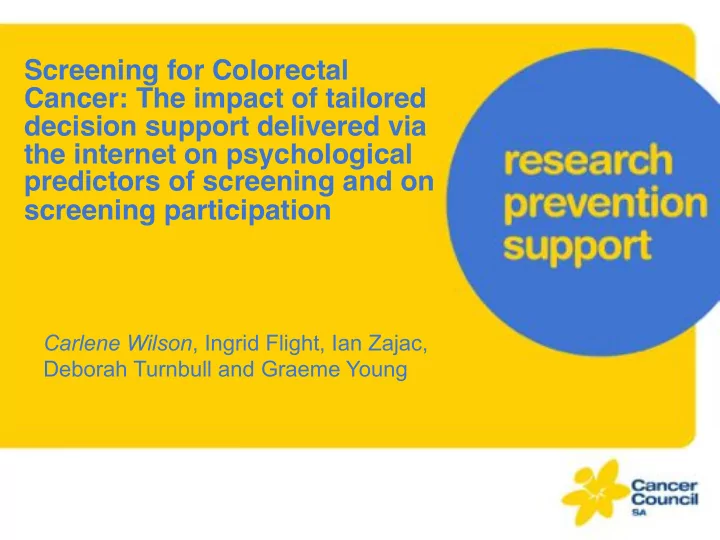

Screening for Colorectal Cancer: The impact of tailored decision support delivered via the internet on psychological predictors of screening and on screening participation ! Carlene Wilson , Ingrid Flight, Ian Zajac, Deborah Turnbull and Graeme Young
The problem and study goals ! • " Colorectal cancer morbidity and mortality. " • " Roll-out of National Bowel Cancer Screening " Program utilising bi-annual FOBT " – Sub-optimal participation rates " • " Why – psychological predictors? " • Improve attitude to screening AND participation rates. " • Achieve by tailoring communication in line with psychological predictors . " • Deliver these messages in a cost-effective and convincing manner . " !
Hypothesis ! • Messages tailored in real time on PHM and PAPM and delivered as personalised feedback online will lead to improved performance on psychological predictors of screening and improved participation. " • This approach will be more effective than: " – Web-based, non-tailored. " – Paper-based, non-tailored. "
Design and Participants ! • Three group randomised, controlled trial. " • Total n = 3,408; mean age 60 yrs (SD=6 yrs ); range = 47-75 yrs ; 49.1% male " • Groups " – 1. Tailored web (n=1,137; M age =60 yrs (SD=6 yrs ); Range = 50-75 yrs ; 49.2% male) " – 2. Non-tailored web (n=1,136; M age =60 yrs (SD=6 yrs ); Range = 47-75 yrs ; 48.9% male) " – 3. Non-tailored paper (usual care) (n =1,135; M age =60 yrs (SD=6 yrs ); Range = 49-75 yrs ; 49.1% male) " • Intervention was exposure to material: " – 1. Messages designed to motivate or reinforce responses to psychological variables (PHM) demonstrated as influence stage of readiness to screen (PAPM) in previous research. " – 2. Access to the online information and educational materials supplied in the National Bowel Cancer Screening Program. " – 3. Access to the paper book of information and educational materials supplied in the National Bowel Cancer Screening Program . "
Procedure and Dependent Variables ! • Baseline survey assessment (Dependent variables): " – PAPM " – PHM (Risk Perception; Salience and Coherence of screening; Cancer Worries; Response Efficacy and Perceived Social Support). " – Additional variables: Self efficacy for FOBT use, Faecal Aversion " • All who completed the questionnaire received an FOBT " – 1. Tailored web (n=719) " – 2. Non-tailored web (n=710) " – 3. Non-tailored paper (n=811) " • Endpoint survey assessment (Dependent variables): " – PAPM " – PHM " – Additional variables " – Return of kits (6 weeks; 12 weeks). " "
Results – Significant Changes on Psychological Variables ! Psych&variables& Salience&&& Cancer&Worries& Self?efficacy& Faecal&Aversion& ! returning& Coherence&& (F,&p)& (F,&p)& (F,&p)& significant& (F,&p)& ! effects& Time%(Baseline,% 11.72%% p <.001% 21.17% p <.001% Endpoint)% % Time%X%Group% 5.81% p <.003% 7.01% p <.001% 7.81% p <.001% (Tailored%Web,% Non@tailored% Web,%Paper)% Time%X% 7.86% p <.005% 9.12% p <.003% 98.3% p <.001% 28.41% p <.001% ParEcipaEon% % Status%(Yes,%No)% Time%X% 4.68*% p <.01% IntervenEon%X% ParEcipaEon%% * Non-significant after Bonferroni correction for multiple comparisons
Results – Differences in kit returns at 6 and 12 weeks ! Return&rate&for&FOBT&at&6& Return&rate&for&FOBT&at& weeks&post&mail&out& 12&weeks&post&mail&out& & Tailored%Web% N=539,%or%74.9%% N=590,%or%82.1%% % (539/719)% (590/719)% Non@Tailored%Web% N=539,%or%75.9%%% N=593,%or%83.5%%% % (539/710)% (593/710)% Non@Tailored%Paper% N=572,%or%70.5%% N=619,%or%76.3%% % (572/811)% (619/811)% Chi 2 ,%probability% χ 2 %(2)%=%6.58,% p =.037%% χ 2 %(2)%=%14.21,% p <.001% (locaEon%of%significant% (1%and%2%cf%3)% (1%and%2%cf%3)% difference)% %
Discussion ! • Tailoring doesn’t improve participation; web does . " • What changes with exposure to the intervention? ! • Tailoring can help change the variables that previous studies have linked to stage of readiness to screen: " – Salience and coherence (PHM) enhanced by tailoring as is self-efficacy. Faecal aversion is decreased more by tailoring. " • Which psychological variables are linked to participation in our study, irrespective of intervention group? ! • Salience and Coherence increased in participants; decreased in non- participants. " • Cancer Worries decreased in participants; increased in non-participants. " • Self-efficacy increased in participants; decreased in non-participants. " • Faecal aversion decreased in participants; unchanged in non-participants. " • Changes in psych constructs in intervention groups are not clearly related to participation. !
Recommend
More recommend